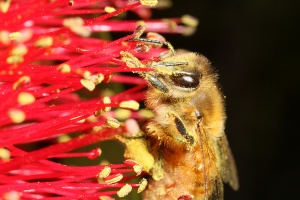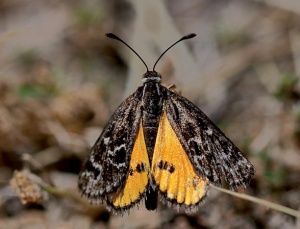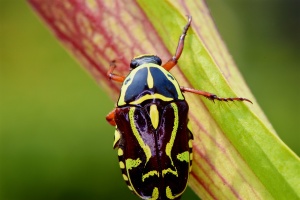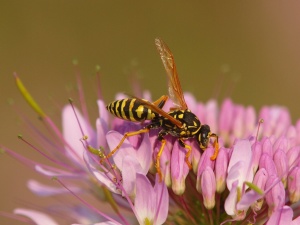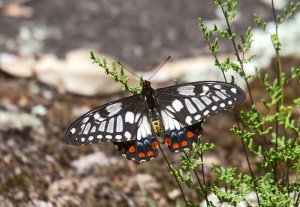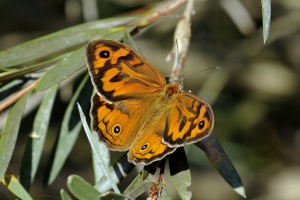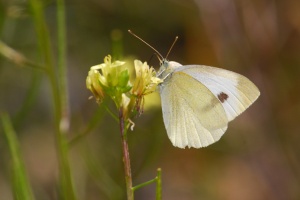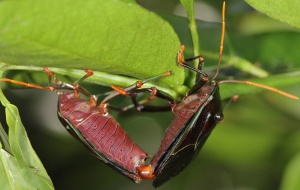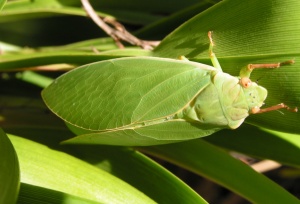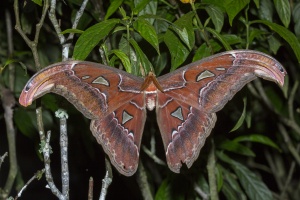Jen Sutfin
Honey Bee
The Honey Bee's head, upper body and legs are black, and its hairy abdomen is striped black and brown (or yellow/orange). It is pale when it first emerges from the nest, but soon develops a darker colouring.
Size
1.2 – 1.6 cm long (Queen bee is slightly longer)
Golden Sun Moth
The male has dark brown forewings (front wings) with pale grey scales, and bronzy-brown hindwings with dark brown patches. The undersides of both wings are pale grey and black. The female has bright orange hindwings with black spots near the edge, while its forewings are similar to the male’s but more grey than brown. The underside of all its wings is white with small black spots near the edge. Both sexes have green eyes.
Distinctive feature
Its antennae are clubbed, with a knob at the end.
Size
Male wingspan 3.4 cm, female wingspan 3.1 cm.
Fiddler Beetle
A beetle with a shiny black back and head with bright yellow-green markings, and dark brown to black legs.
Distinctive feature
Violin-shaped markings on its back (after which it is named).
Size
About 2 cm
European Wasp
Bright yellow and black bands across its abdomen, with a pair of black spots and a black triangle on each yellow band. It has yellow legs, black antennae and two pairs of transparent wings. Nests are commonly built underground with only their small entrance holes visible, which are about 2 - 3 cm across.
Size
1.2 – 1.5 cm long (worker); 2 cm long (queen)
Dainty Swallowtail
The caterpillar (larva) is initially dark in colour with broad yellow-orange bands running across its body, and two rows of black spines running down its back. Its head is black and smooth. As it matures its body becomes blue-black. Just before becoming a pupa it turns dark green with orange-yellow blotches on its back and some small scattered pale blue-and-white spots. The butterfly (adult) has black wings covered with white-grey patches, and red-and-blue patches on its hindwing. The back edge of its hindwing is scalloped and the tip of its body is yellow.
Size
Caterpillar up to 4 cm long; Butterfly wingspan about 7 cm.
Common Brown Butterfly
The caterpillar (larva) is initially a pale yellow-grey, before turning green with long black hairs along its body. Its head is brown-black with short hairs. The female butterfly (adult) is orange with creamy yellow and dark brown patches towards the tip of its forewings (front wings). The male is less colourful, being brown and orange with no pale patches. It also has an obvious raised vein in the middle of its forewing. Both males and females have a small eye-spot on each wing. The undersides of the wings in both the male and female are paler with faint markings, and their hindwings have very few markings. The female’s hindwing is darker then its forewing. It is difficult to identify these butterflies when they are resting with their wings closed. The males emerge quite a while earlier in the year before the females.
Size
Caterpillar about 3.5 cm long; Butterfly wingspan 5.5 – 7.5 cm (females are larger than males).
Cabbage White Butterfly
The caterpillar (larva) is initially pale yellow with fine hairs, before turning green. It has narrow yellow lines on its body which are sometimes hard to see. The upper side of the butterfly (adult) is white with a black tip on its forewing (front wing) and a black patch on the front edge of its hindwing. A male has one black spot on its forewing, while a female has two black spots. Looking from underneath, the forewing is white with two black spots and the hindwing is yellow.
Size
Caterpillar about 3.5 cm; Butterfly up to 5 cm wingspan.
Bronze Orange Bug
Baby bugs (nymphs) are initially bright green as are the eggs from which they hatch, before turning orange-red with a black dot on their back. An adult is bronzy-black with a broad thick body and a triangular back plate. Its head is small in relation to the rest of its body and it has orange antennae and leg joints.
Size
Eggs are about 2.5 mm in diameter; adults are about 2.5 cm long.
Bladder Cicada
It is likely that by all emerging at the same time of year, cicadas can increase their chances of survival by overwhelming predators with their huge numbers. This means that at least some of the cicadas survive to lay eggs, ensuring the survival of the species.
A green, stout body with opaque green, leaf-like wings and pink-brown eyes with two pairs of wings that are strengthened with veins. Its antennae are small and bristle-like. The male has a greatly enlarged hollow bladder.
Size
Female 3 – 3.5 cm long, Male 4.5 – 5 cm long; Wings 4 – 5 cm long.
Atlas Moth
The Atlas Moth is a very large, iconic insect with a wingspan of approximately 17cm. It is rusty-brown in colour, with a double white band and a large white spot on each wing.
Eggs are white and almost spherical, each laid singly on a leaf.
Caterpillars can be white to green, 10cm or longer, with floppy spines.

